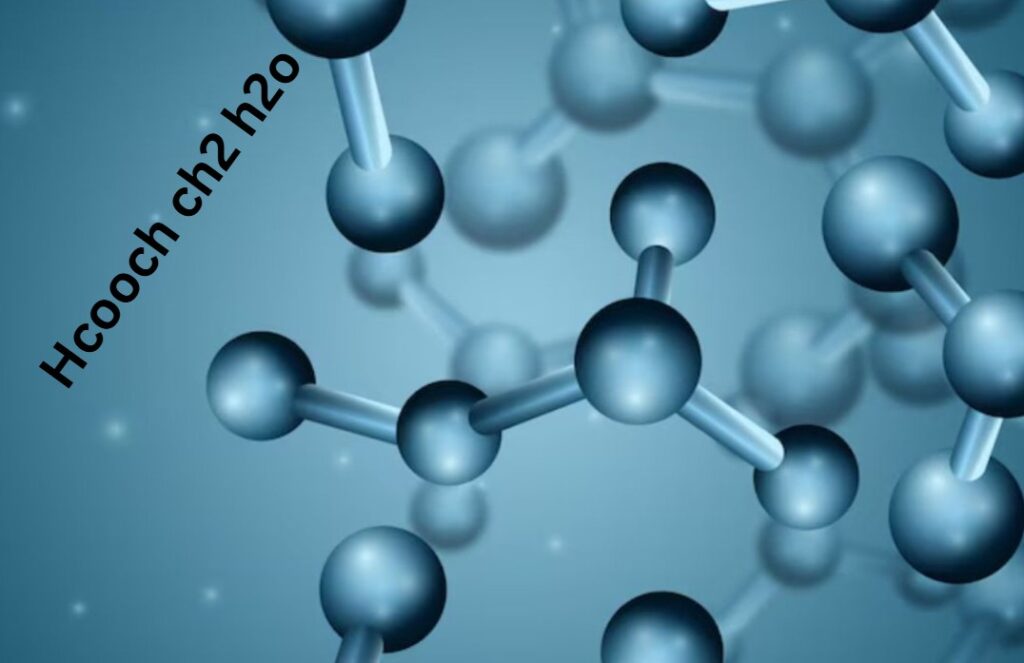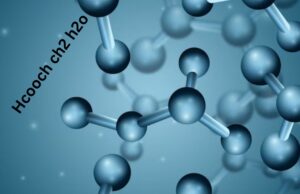
Hcooch ch2 h2o
Chemistry is a complex science that explains the very building blocks of matter, and within this expansive field lies the fascinating study of organic compounds. Among them is a somewhat lesser-known but important molecule: Hcooch ch2 h2o, a compound that combines the structure of an ester and an alcohol. Often discussed alongside H₂O (water) in reaction mechanisms and solvent systems, this compound provides valuable insight into organic synthesis, reaction mechanisms, and industrial applications. This article delves deep into the chemical structure of Hcooch ch2 h2o and H₂O, their interactions, properties, and why understanding this molecule is significant in both academic and practical contexts.
What is HCOOCH₂CH₂OH?
HCOOCH₂CH₂OH is the molecular formula for 2-hydroxyethyl formate, a compound formed from formic acid (HCOOH) and ethylene glycol or ethanol depending on the synthesis route. This molecule contains both ester and alcohol functional groups, making it a versatile intermediate in organic reactions.
Its structure can be broken down as follows:
- HCOO– represents the formate ester group derived from formic acid.
- CH₂CH₂OH is the 2-hydroxyethyl group, a two-carbon chain ending in a hydroxyl (-OH) group.
The chemical structure of Hcooch ch2 h2o features:
- A carbonyl group (C=O) from the formate.
- An ether linkage formed through esterification.
- A terminal hydroxyl group, which maintains the molecule’s hydrophilic nature.
This unique structure makes it both polar and reactive, with applications in chemical synthesis, particularly in reactions involving nucleophilic substitution and hydrolysis.
Understanding the Chemical Structure of Hcooch ch2 h2o and H₂O
Let’s break down the Hcooch ch2 h2o chemical structure:
- The carbon in the formate group is bonded to a double-bonded oxygen (carbonyl) and a single-bonded oxygen, which then links to the ethyl group.
- The ethyl group ends with a hydroxyl group, making the molecule a hybrid of an ester and an alcohol.
So the full chemical name, 2-hydroxyethyl formate, reflects its structure: the hydroxyl group is attached to the second carbon of the ethyl chain, and the ester linkage connects it to a formyl group.
As for H₂O, the universal solvent, its role in chemistry cannot be overstated. H₂O is composed of two hydrogen atoms covalently bonded to an oxygen atom, forming a bent molecular geometry due to the lone pairs on the oxygen. This geometry gives water its polar nature, enabling it to act as an excellent solvent for ionic and polar organic molecules, including compounds like Hcooch ch2 h2o.
Synthesis of Hcooch ch2 h2o
The synthesis of 2-hydroxyethyl formate is typically achieved via esterification — a reaction between formic acid and ethylene glycol (or ethanol, in certain conditions). The reaction proceeds as follows:
HCOOH + HOCH₂CH₂OH → HCOOCH₂CH₂OH + H₂O
This reaction is a classic example of condensation, where a small molecule (in this case, H₂O) is eliminated as two reactants combine.
This brings the role of H₂O into sharp focus. In many organic reactions, water acts as both a by-product and a crucial part of equilibrium. The removal of water in esterification reactions often drives the equilibrium toward product formation. Conversely, in hydrolysis reactions, water adds back to esters to regenerate the acid and alcohol — a process relevant when studying the chemical structure of Hcooch ch2 h2o under reaction conditions.
Physical and Chemical Properties
Understanding the physical and chemical properties of Hcooch ch2 h2o helps in its practical use across various chemical industries:
- Molecular Weight: ~90.08 g/mol
- Appearance: Colorless liquid
- Boiling Point: Approximately 170–180°C (depending on purity and pressure)
- Solubility: Miscible in water due to its polar hydroxyl group
- Reactivity: Undergoes hydrolysis in acidic or basic media, and participates in ester-exchange and oxidation reactions.
The presence of both an ester and an alcohol group makes it an interesting bifunctional molecule. The hydroxyl group can act as a nucleophile in further reactions. While the ester can be hydrolyzed or transesterified under the right conditions.
When dissolved in H₂O, hydrogen bonding occurs, increasing its solubility and altering its reactivity in aqueous environments. This is particularly important in biochemistry and green chemistry. Where water is preferred as a solvent due to its environmentally benign nature.
Applications in Industry and Research
Hcooch ch2 h2o may not be as widely used as other esters or alcohols, but it plays several roles in niche applications:
- Intermediate in Organic Synthesis: The molecule can serve as a building block for pharmaceuticals, agrochemicals, and fragrances. Its dual functionality allows it to participate in a variety of reactions, including ring-forming reactions, oxidations, and substitutions.
- Solvent or Co-Solvent: Its solubility in both organic solvents and water makes it valuable in reactions where solvent polarity needs fine-tuning. It can modulate the dielectric constant of the solvent system, especially when mixed with H₂O.
- Research into Reaction Mechanisms: Hcooch ch2 h2o is used in studies of ester hydrolysis and oxidation reactions. The interaction between its hydroxyl group and aqueous media provides insight into intramolecular hydrogen bonding and reaction rates.
- Green Chemistry Applications: Because it can be synthesized from formic acid and ethylene glycol — both of which can be derived from renewable resources. It has potential in sustainable chemical manufacturing. Its reactions in H₂O also align with the goals of reducing harmful solvents.
Role of H₂O in Reactions Involving Hcooch ch2 h2o
Water (H₂O) plays multiple roles in the life cycle of an organic compound like Hcooch ch2 h2o. It can act as:
- A reactant in hydrolysis reactions.
- A product in esterification.
- A solvent that facilitates ionic and polar reactions.
- A medium that enables hydrogen bonding and stabilizes transition states.
In a laboratory or industrial setting, the chemical structure of Hcooch ch2 h2o changes its interaction with water depending on pH, temperature, and catalysts. Under acidic conditions, hydrolysis of the ester bond can occur readily, reverting it to formic acid and ethylene glycol:
HCOOCH₂CH₂OH + H₂O → HCOOH + HOCH₂CH₂OH
This reverse reaction demonstrates the reversible nature of esterification and the dynamic role of H₂O in organic chemistry.
Environmental and Safety Considerations
As with all organic compounds, handling 2-hydroxyethyl formate requires attention to safety and environmental impact:
- Toxicity: It is generally considered to have low toxicity, but direct skin contact or inhalation should be avoided.
- Flammability: It is combustible and should be stored away from open flames.
- Biodegradability: Due to its polar nature and water solubility, it is more easily biodegradable than many hydrophobic esters.
- Disposal: Must be disposed of according to local environmental regulations to avoid water contamination. Especially given its interaction with H₂O and aquatic systems.
Future Research and Emerging Uses
With the rise of green chemistry and sustainable practices, interest in compounds like Hcooch ch2 h2o is likely to grow. As researchers look for biodegradable solvents and low-toxicity intermediates, multifunctional molecules with high solubility and reactivity become increasingly attractive.
Research may also explore:
- Its role in drug delivery systems, particularly in aqueous formulations.
- Polymer precursors, where its alcohol group allows polymer chain initiation.
- Bio-based plastics, as a component in the formation of biodegradable polymers.
Additionally, computational chemistry and spectroscopic analysis continue to uncover the nuances of the HCOOCH₂CH₂OH chemical structure and how it behaves in complex aqueous systems involving H₂O.
Conclusion
The molecule Hcooch ch2 h2o – 2-hydroxyethyl formate – is a chemically intriguing compound due to its dual functional groups and its interactions with water. Its chemical structure, combining an ester and an alcohol. Allows it to participate in a wide range of organic reactions, particularly in aqueous environments. The role of H₂O is not just as a solvent but as a critical player in synthesis, hydrolysis, and stabilization of such compounds. While it may not be as widely known as other esters or alcohols. Its importance in research, synthesis, and potential future applications cannot be overstated.
Understanding molecules like HCOOCH₂CH₂OH enhances our grasp of organic chemistry’s fundamentals, enabling more efficient, sustainable, and innovative chemical processes. As industries shift toward greener methods, compounds like this – especially in tandem with water – may play a crucial role in shaping the future of chemistry.






